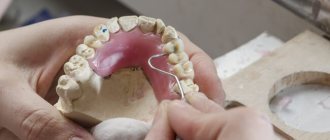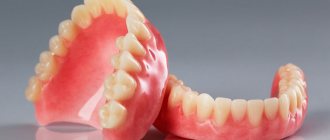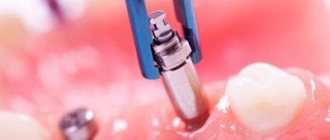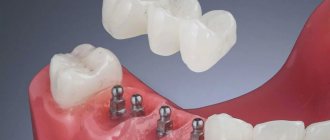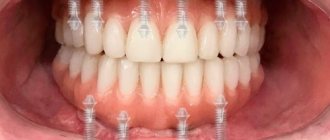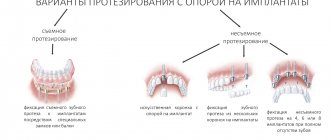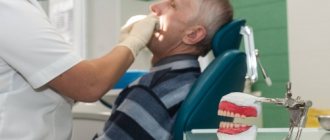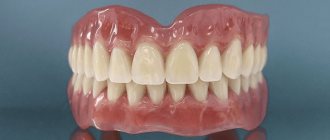The prosthetic procedure is the restoration of damaged or lost teeth, allowing not only to get a beautiful smile, but also to fully realize chewing functions. Various types of dental prosthetics used today make it possible to restore one tooth, several, and even the entire dentition.
First of all, from the point of view of patient convenience, dentures can be removable or non-removable. If it is necessary to replace one or more teeth, dentures are often permanent. In case of complete loss of dentition, previously only removable dentures were used, but today it is possible to install fixed dentures on implants.
Indications for prosthetics
As already noted, prosthetics are recommended to be performed with fixed dentures. Because they are more convenient and reliable. But is it possible to put a removable denture on 1 tooth? Of course, there are practically no contraindications here. The main list of conditions when the need for removable monoprosthetics arises is as follows:
- missing 1 tooth along with the root,
- the natural crown is completely destroyed, but the root is healthy and is being “prepared” for fixation of the stump tab with a crown: during the waiting stage, a removable denture is worn,
- an implant has been installed, but the crown has not yet been fixed on it: the healing (fusion with the bone) of a single implant can last 3-6 months, so a plug is placed on it and the gum is sutured. During this period, a temporary prosthesis is installed for aesthetics and to protect the gums from injury.
The exception is patients with absolute contraindications to fixed prosthetics or implantation. For example, in case of severe diseases of the body, poor blood clotting, intolerance to anesthesia, in childhood, during pregnancy and lactation, the “removal device” is worn for a long time on an ongoing basis.
There are certain indications for installing a removable denture on one tooth, which depend on the type of orthopedic design. Therefore, we will dwell on them in the appropriate sections.
Installation steps
Installation of removable dentures includes several stages:
- Examination. A mandatory procedure, without which it is impossible to imagine the installation of a dental structure. During the examination, the doctor determines the condition of the oral cavity, the presence of possible diseases and defects, and chooses which prosthetics is more reasonable - complete or partial, and the type of design.
— Treatment (if necessary). So that the patient does not have to get rid of diseases after installation of the prosthesis, all therapeutic measures should be carried out in advance. In addition, various pathological processes in the oral cavity sharply reduce the service life of the prosthesis.
— Preparation for prosthetics. To determine the shape of the gums, the doctor makes an impression of the jaws using a special mass. These casts will then be used to make prosthetics that best match your anatomical features.
— Checking the structure in the oral cavity. This is a kind of fitting when the doctor evaluates how suitable the manufactured prosthesis is for you. At this stage it can be adjusted and made comfortable to wear.
- Installation. Fixation of the prosthesis in the oral cavity.
What problems can be avoided?
Let's consider what problems can be solved when using prosthetics with a removable orthopedic design:
- the aesthetics of the smile is restored,
- the gums in the area of the row defect (missing tooth) are protected from injury by hard pieces of food,
- bite relationships and occlusion are preserved: therefore, the antagonist (opposite from above or below) does not move down or up,
- neighboring teeth are not so overloaded during chewing,
- The teeth adjacent to the defect do not move: if you leave a “gap” in the row and do not perform prosthetics, then the “neighbors” on the right and left will gradually shift towards it. Thus, in the future it will be difficult to install a prosthesis or even have to wear a brace system.
Benefits for use
Long-term absence of teeth can lead to various dental problems. Removable dentures allow you to avoid the following:
- Displacement of adjacent teeth in a row towards the defect. This is a slow process that leads to changes in the bite. The defect accelerates when a person begins to chew food on one side of the jaw.
- Increased load on remaining teeth. The jaw quickly adapts to changing conditions. This is manifested by the reformation of functional groups in the mouth. Such repurposing leads to increased abrasion of the enamel and destruction of fillings.
- Moving the antagonist tooth towards the defect. The tooth seems to increase in size. In fact, there is no growth. It simply slides out of its own hole, since there is less load on it.
- Excessive load on the temporomandibular joint. This occurs due to changes in the bite. As a result, the TMJ becomes deformed. The patient experiences pain while chewing and difficulty opening the mouth.
- Changes in the tone of the jaw muscles. A person cannot chew food normally. It enters the stomach in large pieces, which leads to problems with the gastrointestinal tract.
One cannot help but mention psychological problems. Temporary dentures allow you to quickly restore the aesthetics of your smile. This means that the patient will not feel awkward when communicating with other people.
Types of orthopedic structures
A removable denture for one tooth can be of 2 types - an immediate prosthesis or “butterfly” and a splinting clasp. They belong to partial orthopedic structures, because placed in case of partial edentia. They are placed in certain clinical situations and have different appearance (as well as purpose). Let's consider their features further.
Don't know what type of prosthetics to choose?
We will help in the selection, advise where to read more information and compare types of prosthetics.
Consultation with an orthopedic doctor in Moscow clinics is free! Call now or request a call
Working hours: from 9:00 to 21:00 - seven days a week
Immediate prosthesis or “butterfly” - characteristics, pros and cons
“Butterfly” is a removable denture for 1 tooth, which looks like a dental crown with pink “wings” or hooks on the sides (4 hooks in total). How does such an orthopedic structure hold up? With these hooks, otherwise called “clasps,” the prosthesis covers the adjacent supporting teeth and is thus fixed. The crown is made of light-colored plastic, and the hooks, which are a continuation of the base, are made of elastic or hard pink polymer. Based on the material from which the artificial gum is made, acrylic and nylon dentures for 1 tooth are distinguished. Moreover, both classic acrylic and the more modern monomer-free material Acry-free (“Acry-free”) can be used.
- indications: suitable for all groups of patients, but only if there are included row defects,
- an absolute contraindication is a terminal defect - the absence of the last molar in the row: in this case, the butterfly clasps on one side will have nothing to attach to,
- advantages: quickly manufactured, easy to install, quick adaptation,
- Disadvantages: the hooks quickly stretch, the fixation of the structure becomes worse - you have to use a special adhesive cream or change the product. Chewing function is not restored very well. They do not stop bone tissue atrophy under the crown (where there is no root). Without load, the bone decreases in size and sags, causing discomfort and decreased aesthetics.
Another contraindication is too young age (up to 2-4 years) and the presence of mental illness, epilepsy. In such situations, the patient may unknowingly swallow the structure.
Read on the topic: immediate dentures - what they are, types, advantages and disadvantages.
Clasp splinting – features, pros and cons
A clasp denture with a splinting function is similar to a traditional one in that a metal arch is placed inside its base - this frame imparts rigidity, facilitates chewing food and correctly distributes the load. Additionally, the design includes claw-shaped or ring-shaped processes made of metal, occlusal pads, with the help of which splinting of mobile teeth occurs. In the upper jaw, this design does not have a massive palatal overlap, but only a thin plate or bridge.
- indications: used for included and end defects, but only in the presence of mobility of the remaining teeth (with periodontitis and periodontal disease),
- advantages: they perform 2 functions at once - they restore missing teeth and stabilize remaining teeth. They distribute chewing pressure well, it is much more convenient to chew with them than with “butterflies”,
- disadvantages: large mass of the structure, does not stop the atrophy of the jaw bone.
Rules for care and wearing
How to wear a mono-prosthesis? Removable “butterflies” require regular removal - after each meal or even eating thick yogurt, the orthopedic structure will have to be removed from the mouth and washed in water. There is no need to remove the splinting “clasps” every day; by the way, this can even be dangerous, because there is a risk of severe loosening. With any denture option, you will have to carefully observe oral hygiene - brush and paste twice a day, and soak the denture in a disinfectant solution once a week. You will have to visit the dentist approximately 1-2 times a year for examination and relocation of the structure, because... due to bone atrophy, the fit of the base becomes less dense.
Dietary recommendations limit and even prohibit the consumption of hard foods - chunky hard meat, fresh hard vegetables and fruits (you have to grate them first), toffees and toffees. Therefore, the “butterflies” are weakly fixed and can fly off, and the teeth under the splinting clasps can become very loose.
Life time
Such a prosthesis can last from 2 months to 2 years. The service life depends on the needs of the patient, the materials used in the manufacture and the design features of a particular model.
Plastic products equipped with metal fasteners last the longest. Nylon and acrylic butterflies are not as durable due to the insufficient strength of the materials.
It is worth understanding that any prosthesis will sooner or later become unusable. They crack and begin to wobble. This can lead to injury to the jaw, so at the first sign of defects you should consult a specialist.
You can increase the service life of the product with proper care. This involves regularly cleaning your dentures with a soft brush and toothpaste. At night it is better to remove it and place it in a special container with an antiseptic. A disinfectant solution can be purchased at a pharmacy or made independently using special tablets. The antiseptic in the container must be changed regularly.
You should not remove your denture too often. This can lead to displacement of the clasps, which will cause discomfort when wearing the product.
Which option to choose among removable ones?
Which prosthesis[1] should I put on one tooth? It is recommended to select the best option individually, together with an orthopedic dentist. If the speed of prosthetics is important, and the supporting teeth do not have pathological mobility, then it is better to choose a “butterfly” made of acrylic or “Acry-free” for the chewing part of the row. Nylon, of course, is comfortable, but for a very short time, and a stretched product will have to be changed soon. In the presence of pathological mobility, only the splinting clasp remains.
But do not forget that all the options considered are recommended for temporary use only. They are not very securely fixed (especially in the “smile zone”, where the supporting crowns are not so wide) and do not stop bone tissue atrophy. Therefore, it is better to turn to alternatives.
“I wore a bow tie during pregnancy until I could get an implant. It’s not very convenient, and you have to constantly clean it. But I was afraid that without a prosthesis, neighbors would move towards each other, and I would generally suffer later. I was afraid that it would fall out while eating and I would swallow it. Therefore, I had to chew very carefully.”
Olga R., review from baby.ru
Examples of prostheses made in our laboratory
Thermoplastic (clasp) "Quattroti".
ACRY FREE (acrylic free).
Nylon removable denture.
The article was checked by: Meleshkin Dmitry Vladimirovich
If you liked this post, share it with your friends and subscribers.
Alternatives – fixed dentures and implantation of 1 tooth
If you choose among temporary dentures for one tooth, then the best alternative option is an adhesive fixed bridge. Visually, this is a crown with two small “wings” on the sides that are glued to the supporting teeth. Most often it is placed on the upper or lower front teeth, because in the chewing areas there is too much load and the fixing composition will quickly come off. An adhesive bridge is made of plastic or composite composition.
The classics of permanent fixed prosthetics are bridges. Those made from metal ceramics and zirconium dioxide are the most durable, and ceramic ones look very aesthetically pleasing. The service life, depending on the material, is 7-20 years, but there are also disadvantages. For example, for bridges it is necessary to remove the pulp and grind down the adjacent supporting teeth. And the cost of such a restoration is comparable to the best prosthetic option – a crown on an implant. By the way, the latter will not have such a problem as progressive bone atrophy, since only an implant restores the missing tooth root. And in terms of cost, implantation in the economy and even in the middle class is comparable to prosthetics using a classic bridge. And in terms of service life, a crown on an implant lasts 2-3 times longer.
%akc72%
How to install dental bridges
If you had to remove a tooth, then after the hole has healed, it is recommended to install a bridge. There may be several stages. When manufacturing metal-ceramics, it will be necessary to turn the supports, take an impression, make the structure, try on and adjust.
If you choose ceramics or zirconium, then thanks to CEREC technology an impeccable model is immediately created, taking into account all the nuances. Come for a consultation, and together we will consider all the options for restoring your dentition, choosing a rational method and maintaining your quality of life.
Cost of dental restoration
How much does a denture cost for one tooth? In Moscow and the regions, the price of an immediate prosthesis averages 6000-7000 rubles, and a splinting clasp prosthesis costs from 60 thousand rubles. Also, before prosthetics, it is necessary to undergo the removal of tartar and plaque, treatment of existing caries, pulpitis, stomatitis - all these procedures are paid separately.
[1] Abolmasov N.G. Orthopedic dentistry, 2002.
Author: Sambuev B. S. (Thank you for your help in writing the article and the information provided)
